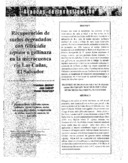| dc.contributor.author | Jiménez Otárola, Francisco | es_ES |
| dc.contributor.author | Collinet, Jean | es_ES |
| dc.contributor.author | Mazariego, Manuel | es_ES |
| dc.date.accessioned | 2015-03-19T22:06:27Z | |
| dc.date.available | 2015-03-19T22:06:27Z | |
| dc.date.issued | 1998 | |
| dc.identifier | 456967 | es_ES |
| dc.identifier.issn | 1022-7482 | es_ES |
| dc.identifier.uri | https://repositorio.catie.ac.cr/handle/11554/6758 | |
| dc.description | Ilus. 4 fig. 1 tab. 14 ref. Sum. (En, Es) | es_ES |
| dc.description.abstract | Durante tres años se estudiaron los cambios en los rendimientos de maíz y frijol y en los suelos de la microcuenca del río Las Cañas, en El Salvador, después de la aplicación de dos tipos de abono orgánico: gallinaza (estiércol de aves) y follaje de mata ratón (Gliricidia sepium). En ambos tratamientos la producción de maíz fue, en promedio, un 25 por ciento superior al testigo (labranza tradicional). Los rendimientos de frijol en el tratamiento con biomasa incorporada de G. sepium fueron superiores al testigo, mientras que con gallinaza fueron inferiores. La movilización de suelo fue 10 veces menor en el tratamiento con gallinaza, en comparación con el testigo. La materia orgánica aumentó por efecto de las enmiendas aplicadas la aplicación de gallinaza produjo una mayor capacidad de intercambio catiónico en los suelos. Considerando los efectos biofísicos y socioeconómicos que fundamentan el manejo de cuencas, se recomienda el tratamiento correspondiente a la incorporación de 18 ton/ha/año de material fresco (hojas y ramas) de Gliricidia sepium.
Changes in the yields of maize and beans, as well as soil properties, were monitored over a three year period in the micro-watershed of The Cañas river, El Salvador after two types of organic fertiliser were applied: chicken manure and foliage of quick stick (Gliricidia sepium). Maize yields in the chicken manure and G sepium treatments average 25% higher than the control treatment (conventional tillage). Bean yields were higher where G sepium biomass was incoporated while the chicken manure treatment produce lower yields than the control. After three years, the application of organic amendments began to produce an increase of soil organic matter. soil movement was 10 times less in the treatment with chicken manure than in the control. Chicken manure produced the greatest cation exchange capacity. When both, the biophysical anda socio-economic effects, wich are of significance in watershed management, are taken into consideration the incorporation of 18 t/ha/yr of fresh material (leaves and branches) of G sepium is the most recommended treatment. | es_ES |
| dc.language.iso | es | es_ES |
| dc.publisher | CATIE, Turrialba (Costa Rica) | es_ES |
| dc.relation.ispartof | Agroforestería en las Américas (CATIE) Volumen 5, número 20 (1998), páginas 10-16 | |
| dc.rights | info:eu-repo/semantics/openAccess | es_ES |
| dc.subject | GLIRICIDIA SEPIUM | es_ES |
| dc.subject | SUELO | es_ES |
| dc.subject | CUENCAS HIDROGRAFICAS | es_ES |
| dc.subject | ABONOS ORGANICOS | es_ES |
| dc.subject | ZEA MAYS | es_ES |
| dc.subject | PHASEOLUS VULGARIS | es_ES |
| dc.subject | RENDIMIENTO | es_ES |
| dc.subject | ESTIERCOL | es_ES |
| dc.subject | AVES DE CORRAL | es_ES |
| dc.subject | BIOMASA | es_ES |
| dc.subject | AGRICULTURA TRADICIONAL | es_ES |
| dc.subject | EROSION | es_ES |
| dc.subject | CONSERVACION DE SUELOS | es_ES |
| dc.subject | EL SALVADOR | es_ES |
| dc.title | Recuperación de suelos degradados con Gliricidia sepium o gallinaza en la microcuenca río Las Cañas, El Salvador | es_ES |
| dc.title.alternative | Recovery of degraded soils with Gliricidia sepium or chicken manure in The Cañas river micro-watershed, El Salvador | en_EN |
| dc.title.alternative | Recovery of degraded soils with Gliricidia sepium or chicken manure in The Cañas river micro-watershed, El Salvador | en_EN |
| dc.type | Artículo | es_ES |
| dc.journal.issueNumber | 20 | |


